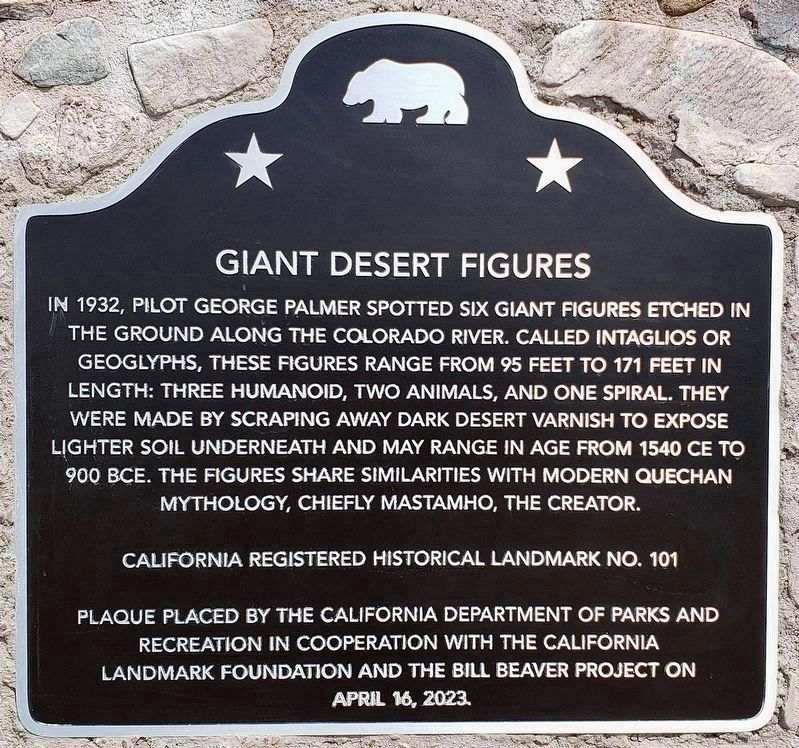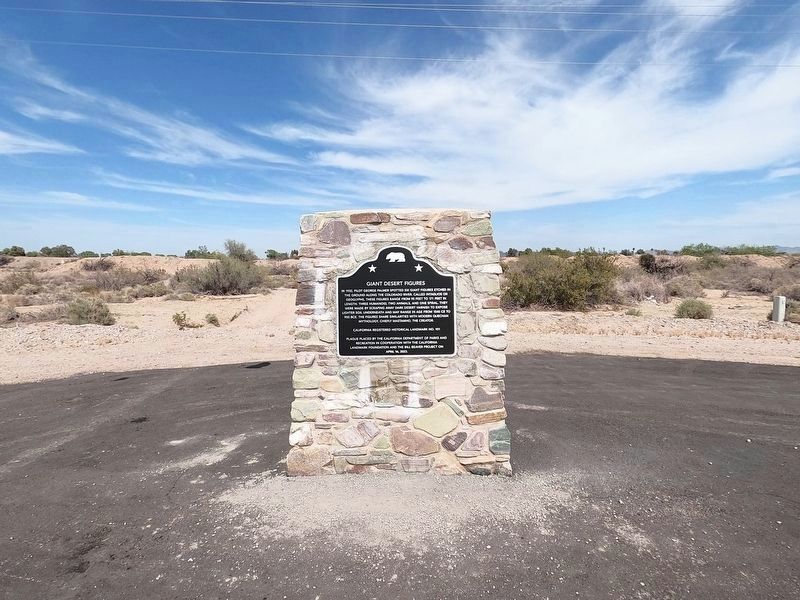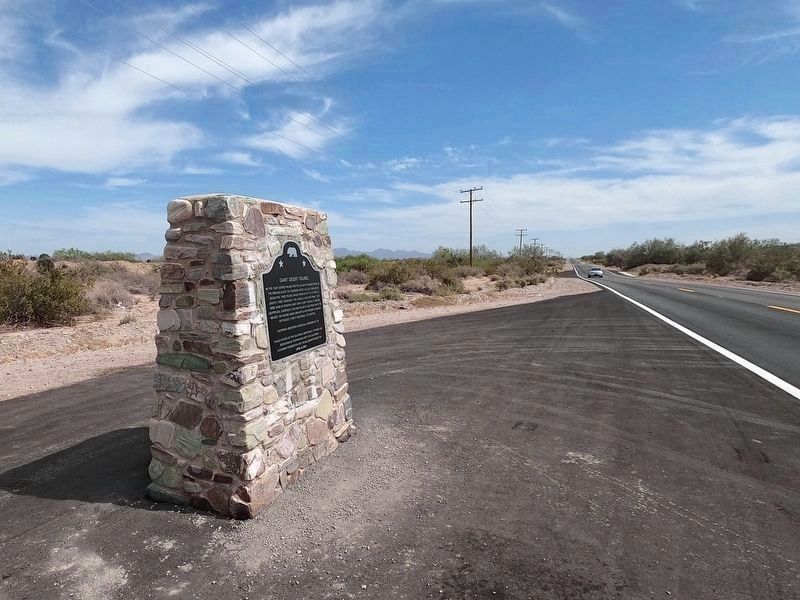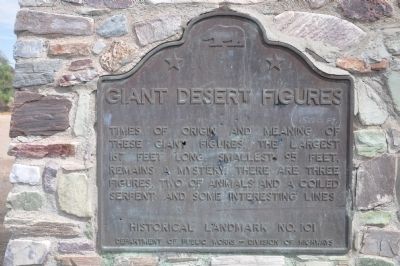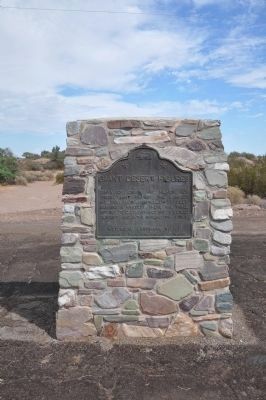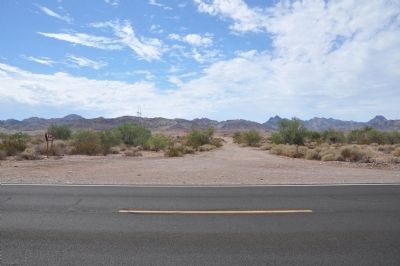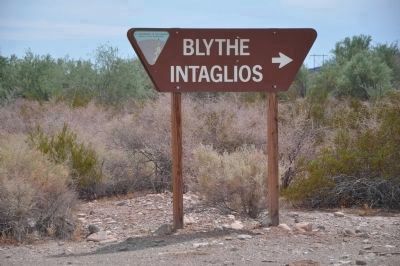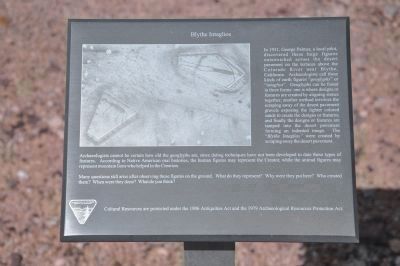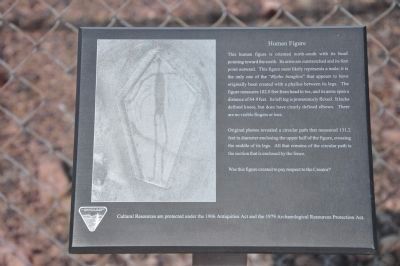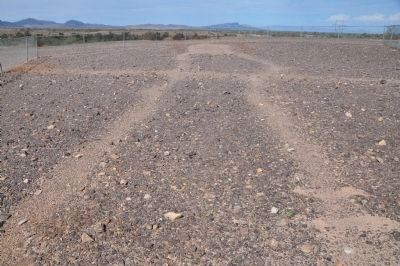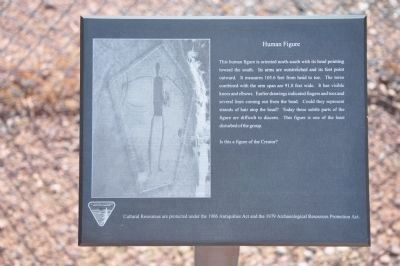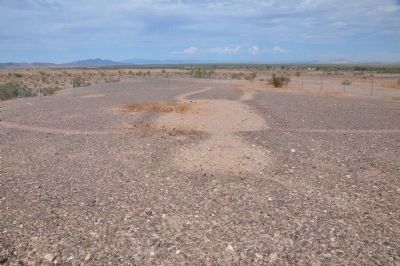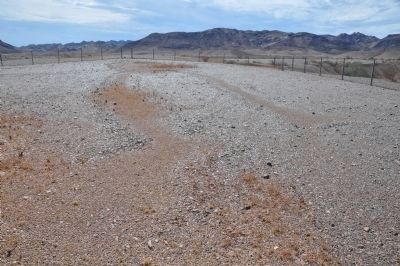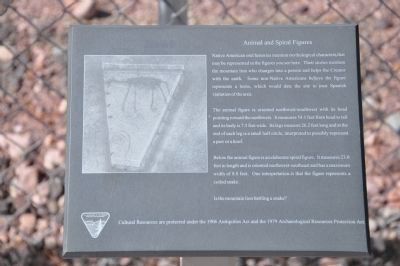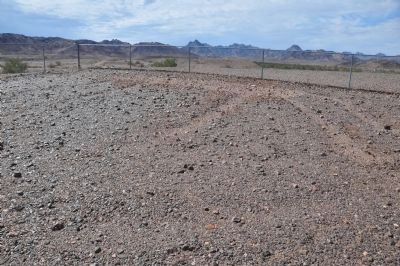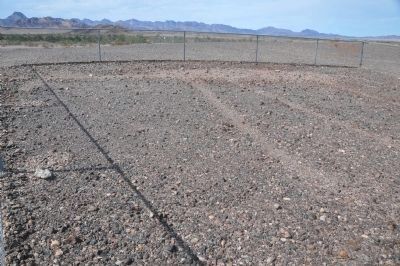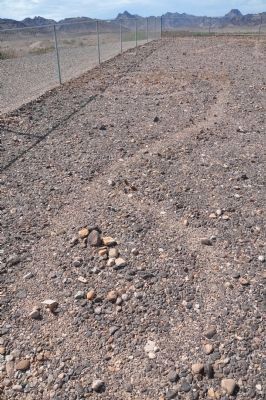Near Blythe in Riverside County, California — The American West (Pacific Coastal)
Giant Desert Figures
Blythe Intaglios
In 1932, pilot George Palmer spotted six giant figures etched in the ground along the Colorado River. Called intaglios or geoglyphs, these figures range from 95 feet to 171 feet in length: three humanoid, two animals, and one spiral. They were made by scraping away dark desert varnish to expose lighter soil underneath and may range in age from 1540 CE to 900 BCE. The figures share similarities with modern Quechan mythology, chiefly Mastamho, the creator.
California Registered Historical Landmark No. 101.
Plaque placed by the California Department of Parks and Recreation in cooperation with the California Landmark Foundation and the Bill Beaver project on April 16, 2023.
original marker, now missing:
Times of origin and meaning of these giant figures, the largest 167 feet long, smallest 95 feet, remains a mystery. There are three figures, two of animals and a coiled serpent, and some interesting lines.
panel #1:
Blythe Intaglios
In 1931, George Palmer, a local pilot, discovered these huge figures outstretched across the desert pavement on the terraces above the Colorado River near Blythe, California. Archaeologists call these kinds of earth figures "geoglyphs" or "intaglios". Geoglyphs can be found in three forms: one is where designs or features are created by aligning stones together; another method involves the scraping away of the desert pavement gravels exposing the lighter colored sands to create the designs or features; and finally the designs or features are tamped into the desert pavement forming an indented image. The "Blythe Intaglios" were created by scraping away the desert pavement.
Archaeologists cannot be certain how old the geoglyphs are, since dating techniques have not been developed to date these type of features. According to Native Americal oral histories, the human figures may represent the Creator, while the animal figures may represent mountain lions who helped in the Creation.
Many questions still arise after observing these figures on the ground. What do they represent? Why were they put here? Who created them? When were they done? What do you think?
panel #2:
Human Figure
This human figure is oriented north-south with its head pointing toward the south. Its arms are outstretched and its feet point outward. This figure most likely represents a male; it is the only one of the "Blythe Intaglios" that appears to have originally been created with a phallus between its legs. The figure measures 102.0 feet from head to tow, and its arms span a distance of 64.9 feet. Its left leg is pronouncely flexed. It lacks defined knees, but does have clearly defined elbows. There are no visible fingers or toes.
Original photos revealed a circular path that measured 131.2 feet in diameter enclosing the upper half of the figure, crossing the middle of the legs. All that remains of the circular path is the section that is enclosed by the fence.
Was the figure created to pay respect to the Creator?
panel #3:
Human Figure
This human figure is oriented north-south with its head pointing toward the south. Its arms are outstretched and its feet point outward. It measures 105.6 feet from head to tow. The torso combined with the arm span are 91.8 feet wide. It has visible knees and elbows. Earlier drawings indicated fingers and toes and several lines coming out from the head. Could they represent strands of hair atop the head? Today these subtle parts of the figure are diffcult to discern. This figure is one of the least disturbed of the group.
Is this a figure of the Creator?
panel #4:
Animal and Spiral Figures
Native American oral histories mention mythological characters that may be represented in the figures you see here. Their stories mention the mountain lion who changes into a person and helps the Creator with the earth. Some non-Native Americans believe the figure represents a horse, which would date the site to post Spanish visitation of the area.
The animal figure is oriented northwest-southwest with its head pointing toward the northwest. It measures 54.1 feet from head to tail and its body is 7.5 fee wide. Its legs measure 26.2 feet long and at the end of each leg is a small half circle, interpreted to possibly represent a paw or a hoof.
Below the animal figure is an elabotate spiral figure. It measures 23.0 feet in length and is oriented northwest-southwest and has a maximm width of 8.8 feet. One interpretation is that the figure represents a coiled snake.
Is the mountain lion battling a snake?
Cultural Resources are protected under the 1906 Antiquities Act and the 1979 Archaeological Resources Protection Act.
Erected by California Department of Parks and Recreation, California Landmark Foundation, The Bill Beaver Project, and Department of Public Works - Division of Highways. (Marker Number 101.)
Topics and series. This historical marker is listed in these topic lists: Anthropology & Archaeology • Arts, Letters, Music • Native Americans. In addition, it is included in the California Historical Landmarks series list. A significant historical year for this entry is 1931.
Location. 33° 47.999′ N, 114° 31.654′ W. Marker is near Blythe, California, in Riverside County. Marker is on State Highway 95 at milepost 15.3,, 16 miles north of Blythe, on the right when traveling north. The intaglios are located approximately 2,000 feet west of the marker, north of the dirt access road. Touch for map. Marker is in this post office area: Blythe CA 92225, United States of America. Touch for directions.
Other nearby markers. At least 8 other markers are within 17 miles of this marker, measured as the crow flies. Blythe Intake (approx. 4.8 miles away); Palo Verde Irrigation District Diversion Dam (approx. 4.8 miles away); In Memory of Hualapai Ancestors (approx. 9 miles away in Arizona); Desert Strike (approx. 9.1 miles away); Pioneer Cemetery (approx. 13.4 miles away in Arizona); Ehrenberg Cemetery (approx. 13˝ miles away in Arizona); Poston Memorial Monument (approx. 14.9 miles away in Arizona); 390th Bomb Group (H) (approx. 16.7 miles away). Touch for a list and map of all markers in Blythe.
Regarding Giant Desert Figures. Sandstone pebbles glazed on one side with "desert varnish," strewn over the surface of the mesa, have been moved away, leaving the earth forming the figures; the pebbles were placed in windrows about the edge as an outline. SOURCE: California Historical Landmarks, California State Parks
Editors note: Intaglios are clearly visible on googlemaps satellite view.
The original bronze plaque was stolen, and a replacement was unveiled on April 16, 2023.
Also see . . .
1. Intaglios - Geoglyphs in the Desert. From the ground, these figures are nearly unnoticable, as can be seen in the photos. From the air, they are clearly obvious. (Submitted on January 2, 2012, by Michael Kindig of Elk Grove, California.)
2. California Landmark Foundation. A community-based, 501(c)(3) organization focused on maintaining and preserving California Historical Landmarks for future generations. They organize fundraising, maintain and replace California Historical Landmark markers and plaques, and educate the public about the importance of the history that built the great state of California. (Submitted on April 17, 2023.)
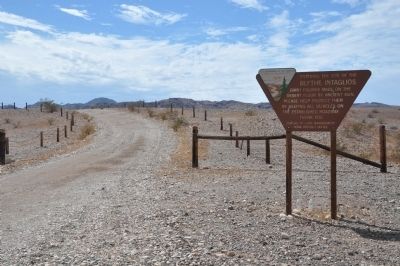
Photographed By Michael Kindig, October 1, 2010
8. Bureau of Land Management Sign
“Entering the Site of the Blythe Intaglios, giant figures made on the desert floor by ancient man. Please help protect them by keeping all vehicles on the established roadway. Thank you. Bureau of Land Management, Yuma District Office”
Credits. This page was last revised on April 17, 2023. It was originally submitted on December 27, 2011, by Michael Kindig of Elk Grove, California. This page has been viewed 1,879 times since then and 114 times this year. Photos: 1, 2, 3. submitted on April 17, 2023, by Craig Baker of Sylmar, California. 4, 5, 6, 7, 8, 9, 10, 11, 12, 13, 14, 15, 16, 17, 18. submitted on December 28, 2011, by Michael Kindig of Elk Grove, California. • Syd Whittle was the editor who published this page.
